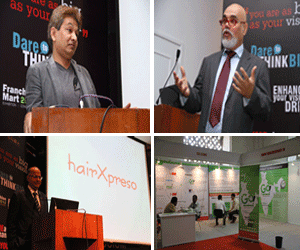Franchising is the practice of using another firm’s successful business model. Franchising is a faster, cheaper form of expansion than adding company-owned stores, because it costs the parent company much less when new stores are owned and operated by a third party.
Essentially, and in terms of distribution, the franchisor is a supplier who allows an operator, or a franchisee, to use the supplier’s trademark and distribute the supplier’s goods. In return, the operator pays the supplier a fee.
Isaac Singer, who made improvements to an existing model of a sewing machine in the 1850s, began one of the first franchising efforts in the United States, followed later by Coca-Cola, Western Union, etc and by agreements between automobile manufacturers and dealers. Modern franchising came to prominence around 1932 with the rise of franchise-based food service establishments.
The definition and the concept of franchising, hence is an old one. In India the concept of franchising is relatively new and still in its infancy. As evident franchising was one of the easiest and sure shot ways to expand into new territories. However, with the rise of e-commerce, spreading to newer geographies and reaching out to new customers is easier than ever before. Is franchising heading towards a slow death for many especially in the retail industry?
Advent of e-commerce:
Tipping point for e-commerce was in 2012 and categories which saw rapid expansions were apparels and accessories, which is expected to overtake electronics. However, building consumer trust and confidence will be the key drivers for sustained growth.
According to the Google report non metros are fuelling the growth.
States such as Andhra Pradesh, Uttar Pradesh, Jharkhand, Punjab, Rajasthan and Tamil Nadu are at the forefront. When it comes to cities it is places like Pune, Chennai, Ahmedabad, Chandigarh, Vijayawada, Jaipur, Cochin and Bhubaneshwar amongst others fuelling the growth.
Trends suggest that as more and more people get addicted to shopping online about 9/10 e-commerce buyers will spend more on online shopping in the next year. According to a Google report there has also been clear shift in the purchases as lifestyle as a category is already bigger than electronics. In the year 2012 8/10 have purchased apparels and accessories versus 7/10 that have purchased electronic goods.
“In 2013, we see apparels and accessories’ queries going up to 35-36 per cent and consumer electronics down from 34 per cent to around 30 per cent because of more options available in apparels and accessories,” says Nitin Bawankule, Industry Director,-E-commerce, Classifieds and Media, Google India.
According to the Internet Economy Watch Report for the month of January 2013, the Internet & Mobile Association of India (IAMAI) indicated a significant growth in the branded apparel segment which witnessed a y-o-y growth of 84 percent. In January 2013, 7.79 million hits were registered on various e-tailing websites as compared to 4.24 million hits in the corresponding period last year. The footwear and jewellery segment also indicated a y-o-y growth of 80 percent and 75 percent respectively in January 2013 when compared with the number of online hits in January 2012.
According to the Google report there are new emerging sectors in the e-commerce business. The star categories on the horizon are baby products, home décor & furnishing and health and nutrition. According to trends monitored about 40 percent e-commerce buyers have purchased baby products, home décor and health /nutrition products.
Top motivators
to shop online
While there can be many hindrances and bottlenecks while shopping online, there are many incentives to buy online. While the most common incentive is buying from the comforts of wherever one is, there are many other factors. According to the Google report cash back guarantee if goods are faulty, ability to pay cash on delivery, fast delivery or same day delivery, substantial discounts compared to market / retail and access to branded products are some of the main reasons.
Top barriers for e-shopping
The biggest hurdle for any e-commerce business is the availability of the internet. India’s vast majority does not have any access to the internet and e-commerce is only available to the ones that are connected. People generally like to touch and try goods before they buy them and that is one of the greatest aspects missing in e-commerce. Despite return policies, users are still apprehensive about returning faulty good and belief that if goods they buy in the market are faulty, it can be returned relatively easily. Also buying in the market gives the buyer the immediate access to goods. Buyers are also wary of posting personal / financial details on the internet. Another aspect that Indian buyers specifically miss is the inability to bargain on the price when they shop online.
The company said online shopping in India saw 128 per cent growth in interest from consumers between 2011 and 2012 compared to only 40 per cent growth in 2010 to 2011, making 2012 the tipping point for online shopping in India.
“With approximately 8 million Indians shopping online in 2012, the online shopping industry in India is growing rapidly and will continue to see exponential growth,” Rajan Anandan, vice president and managing director of Google India said. “By looking at the trends in 2012, we expect 2013 to be a strong growth year for players who’re focused on fast-growing categories like apparels and accessories, and niche product categories like baby products, home furnishings, and health nutrition. We expect the growth to come from outside of the top eight metros.”
Consumer interest on Google search was the highest for consumer electronics at 34 percent, followed by apparels and accessories at 30 percent. Other product categories that Indians searched for online were books (15 percent), beauty and personal care (10 percent), home and furnishing (6 percent), baby products (2 percent), and healthcare (3 percent). According to Anandan as mobile Internet user base grows in India, mobile phones are also becoming a contributor in the surge for online shopping with Google witnessing 2 x growths in the number of queries in 2011 to 2012. “With approximately 8 million Indians shopping online in 2012, online shopping industry in India is growing rapidly and will continue to see exponential growth,” Anandan adds.
IT in Retail
Over the last few years, businesses have been trying to harness the power of information technology to transform the way they work. According to a Boston Consulting Group (BCG) and CII report technology will play an important role in meeting the evolving needs of the Indian consumers. “It is imperative that end user industries re–align their business models and continuously invest in new technologies to provide innovative value propositions to their customers. IT will also be a significant driver in the economic growth of our country due to its effect on increasing productivity and enabling innovation,” says the report.
IT adoption across end user industries is not the same—some sectors like banking, telecom and insurance have leveraged IT across their business functions, including the back–end organizational processes, customer facing activities and revenue generating initiatives, and are at an advanced stage in IT adoption. “Sectors like education, healthcare, media and retail are relatively low IT spenders currently, but are expected to significantly increase their expenditure on this front in the future,” says the report.
According to BCG Indian companies are expected to benefit from such opportunities and build scale over time to play in the global market.
Studies show that till FY2010, India had 141 “billion dollar” companies, which are expected to increase to more than 700 by 2020.
Most of these “billion dollar” companies will have a global footprint and will face challenges from global players. Among the many things that will help these companies succeed, effective use of IT will be an important one.
In such a scenario it is important for the retail industry and for franchisors and franchisees to embrace technology and IT if it has to stay relevant.
Being pertinent
India is the world’s fourth-largest economy in terms of purchasing power parity, and retail plays a crucial role in driving inclusive growth, impacting three key stakeholders: producers, workers and consumers. According to the BCG, India’s retail sector accounted for 22 percent of GDP and 8 percent of total employment. The retail sector in India is largely unorganized, with only 8 percent of the market being organized.
According to the groups latest report the organized segment of retail has been growing at a CAGR of 29 percent, more than double the 12 percent rate of growth for the overall industry. Going forward, organized retail would increase its market share, driven by a host of factors—rising income levels, favorable demographics, increasing urbanization and nuclearization of families, penetration of plastic money, and rising rural consumption.
Some of the key trends that will shape organized retail in India are:
Foreign Direct Investment: With the Government allowing up to 100 percent FDI in single–brand retailing and 51 percent in multi–brand, international retailers will enter / expand their presence in India to grab a piece of the fast–growing local market, says BCG.
organized retail Expansion in tier 2 / 3 cities: Increasing real estate prices in tier 1 cities, lesser competition, and affordable rents would drive retailers to expand their footprint in tier 2 / 3 cities.
Online retail: Increasing Internet penetration, improved payment solutions, a growing base of web–friendly customers, and PE / VCVC–backed E–commerce start–ups would lead to rapid growth of the online retail format in India.
Luxury market: Higher disposable incomes and rise in the number of HNI s will increase the demand for luxury products in India.
Business trends driving IT adoption and key areas of opportunity
“To support their fast growth, organized retailers will have to invest significantly in developing their IT systems to make their operations efficient, cost–effective and scalable,” says BCG report. Some of the areas where IT will play an important role in organized retail are:
Customer interface: Retailers will increase investments in their IT systems to develop solutions that can enable them to provide best–in–class services to customers. Data analytics and customer relationship management are key ITIT capabilities that will be targeted by retailers. Applications for storage and analysis of data will be demanded by retailers. Companies will also seek to identify key factors driving customer decision making and predict future customer mentality, and therefore, will require solutions for the same.
Back–end processes: According to the report organized retail demands very robust and stable back–end systems to ensure that the right products are available at the right time and at the right place. IT spends of retailers would be focused on developing solutions to improve productivity, and managing their operations in an efficient and cost–effective manner.
Supply chain management: Facilitates organized and efficient processes for procurement of raw materials.
Inventory management: Helps maintain a defined process of procurement and reduction of stock–outs.
Warehouse management system: Enables quick decision making on warehousing, logistics support and transportation.
Business management: According to the BCG report IT will play a key role in strategic decision making by providing retailers with real–time information on their business performance. IT-enabled solutions, such as ERP, performance management systems and business intelligence, would allow retailers to accumulate crucial data on business operations so that they can develop insights on key performance indicators—thus improving business performance, meeting targets, and improving returns.
Online retail: Online retail is already a growing phenomenon in India. The presence of more advanced IT systems compared to brick–and–mortar retail is the differentiating factor in online retail. The growing trend of online retail, which is attracting interest from existing retailers, would drive IT investments in this space— both from new and existing retailers, who will seek applications and solutions to increase their presence in the virtual market.
Why for franchise:
“While Indian companies are late adopters of IT and cost sensitive they start from a very low baseline of IT management capabilities and infrastructure, in contrast with their counterparts in developed countries who have an established basic infrastructure,” says the BCG report.
It is time that franchisers and franchisee stop considering IT as a cost center and look at it as a value addition and business growth. “Most Indian companies have traditionally shied away from leveraging IT as a tool to achieve business goals. While most of them use IT, a significant proportion of them still struggle to identify the potential opportunities offered by IT solutions,” says BCG.
Traction is the new IP and a company which can spread its wings to a large market would do well. Franchising needs to be augmented with IT and merely adopting primitive methods of sales would not work anymore.
Low priority for IT in business planning can today be suicidal for a franchise. An inability to envisage IT as a driver of business change has meant that most franchises find it difficult to proactively identify IT requirements across various functions. “As a result, the implementation and upgrades of IT solutions is delayed further, resulting in potential business losses,” says BCG.































 +91 9909960054
+91 9909960054